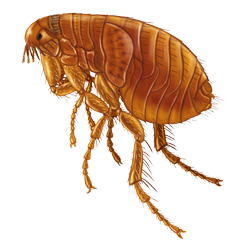Identification
- Colour Normally are brownish-black in colour; however, after feeding they will take on a reddish hue
- Size Measure about 1.5 mm in length, depending on species
- Also known as Siphonaptera

How to identify if you have fleas
Fleas are very small, wingless insects, about 2.5 mm long, dark brown in colour, and visible to the naked eye. The body appears flattened on the sides, giving it a thin appearance. The hind legs are bigger and well adapted for jumping. Fleas are wingless but remain capable of jumping moderate distances by using their long hind legs. They can jump as high as 15 cm vertically and as far as 40 cm horizontally. Flea larvae are whitish, about three to six millimetres long, and have protruding hair encircling each body segment.
Other Key Characteristics
- Are laterally flattened (i.e. flat at the sides)
- Are wingless; cannot fly
- Normally are brownish-black in colour; however, after feeding they will take on a reddish hue
- Have long and powerful hind legs that are adapted for jumping; can jump up to 20 cm vertically and about 40 cm horizontally
- Have short, 3-segmented antennae
- Mouthparts adapted for piercing and sucking
Why do I have fleas
Fleas are sometimes forced inside homes due to prolonged periods of excessively wet weather. Fleas can gain entry into homes by attaching themselves to common household pets. Once inside, the parasites tend to gravitate toward places frequented by potential host animals. Pet beds, as well as cracks and crevices, make popular harbourage sites for fleas.
Where Do Fleas Live
Fleas can be found throughout the world. As part of the flea life cycle includes laying eggs on a warm-blooded animal, they commonly live in areas densely populated by potential hosts. The presence of high humidity and temperatures assists the development of larvae. The pests are sometimes forced inside homes due to prolonged periods of excessively wet weather. Fleas can gain entry into homes by attaching themselves to common household pets. Once inside, the parasites tend to gravitate toward places frequented by potential host animals. Pet beds, as well as cracks and crevices, make popular harbourage sites for fleas.
What Do Fleas Eat
Adult fleas rely on warm-blooded hosts for nourishment. The frequency and duration of feeding varies from species to species. The flea’s mouthpart is modified to pierce a host’s skin and suck up blood. Flea bites often cause irritation and, in extreme cases, can lead to secondary infections. The larvae feed on hair, skin particles, and adult flea feces.
How Long Do Fleas Live
Fleas undergo complete metamorphosis with four distinct stages: egg, larva, pupa, and adult. Once the adult stage is reached, fleas can live up to about a year, although 30 to 90 days represents the typical lifespan. Adult females lay eggs on the host animal after consuming a blood meal. In the right conditions, eggs hatch within 2 to 12 days. Newly hatched fleas spend as many as 200 days in the larval stage before pupating. Generally, the pupal stage lasts between 5 and 14 days. In the absence of a potential host, the pupae can lay dormant until a host shows up before emerging from the pupal stage to adulthood.
How worried should I be about fleas
Fleas can wreak havoc on people and household pets. A severe untreated infestation can kill a cat or dog, but not before the animal undergoes serious suffering. Other medical conditions caused by fleas include bartonellosis (cat scratch fever), feline anemia, and flea allergies.
If a preferred host is unreachable, adult fleas often jump to the first warm-blooded animal that it finds. Most notably, fleas are historically known as carriers of the plague. Fleas are also intermediate hosts of dog and rodent tapeworms; they can transmit the worms to humans and pets.
How can I prevent getting fleas
One of the best ways to prevent a flea infestation is to generally maintain a clean household by steam-cleaning the carpets. The cleaning method works due to the fact that fleas spend up to 90 percent of time away from hosts in furniture or carpeting. Steam cleaning effectively kills fleas in all developmental stages. A comprehensive cleaning will also eliminate any risk of flea infestation in buildings where the parasites might not be apparent due to their ability to go without food for months at a time.
Owners of cats or dogs should thoroughly and regularly inspect pets for fleas. Over-the-counter and vet-prescribed products are available to treat flea infestations on pets, though it also remains imperative to treat the entire house for flea removal. A pest control professional should be contacted to perform such treatments. Regardless, an appropriate, off-the-shelf product can be used for treatment based on label instructions. In addition to targeting fleas directly, look for and remove the nests of wild animals on the property. The removal of unwelcome nests helps eliminate fleas and allows pets to roam freely. For assistance in properly handling and removing a flea infestation, contact a pest control specialist.
Other pests related to Fleas
100% Satisfaction or Money Back Guarantee
Resolving your pest problem is our #1 priority. If re-treatment is required, we'll provide immediate services at no extra cost. If your expectations are not met, we guarantee a full refund of your service payment.
Remove pests from your home, and stop them from coming back
We work hard to listen, understand and assess your unique situation. Request a free, no-obligation estimate today for a customized pest program that fits your needs.
Request a Free Home EstimateRequest a Free Business Consultation

